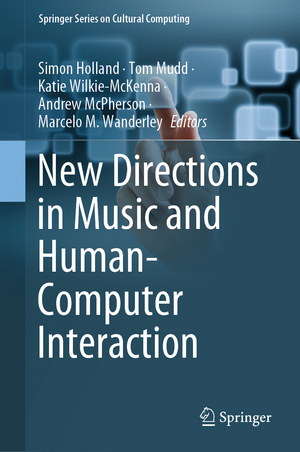New Directions in Music and Human-Computer Interaction: Springer Series on Cultural Computing
Editat de Simon Holland, Tom Mudd, Katie Wilkie-McKenna, Andrew McPherson, Marcelo M. Wanderleyen Limba Engleză Hardback – 22 feb 2019
The book comprises both original research in music interaction and reflections from leading researchers and practitioners in the field. It explores a breadth of HCI perspectives and methodologies: from universal approaches to situated research within particular cultural and aesthetic contexts. Likewise, it is musically diverse, from experimental to popular, classical to folk, including tango, laptop orchestras, composition and free improvisation.
Din seria Springer Series on Cultural Computing
- 20%
 Preț: 648.26 lei
Preț: 648.26 lei - 20%
 Preț: 657.02 lei
Preț: 657.02 lei - 20%
 Preț: 167.45 lei
Preț: 167.45 lei - 20%
 Preț: 259.93 lei
Preț: 259.93 lei - 20%
 Preț: 332.89 lei
Preț: 332.89 lei - 20%
 Preț: 989.96 lei
Preț: 989.96 lei - 20%
 Preț: 660.48 lei
Preț: 660.48 lei - 20%
 Preț: 1308.39 lei
Preț: 1308.39 lei - 20%
 Preț: 936.37 lei
Preț: 936.37 lei - 20%
 Preț: 1164.84 lei
Preț: 1164.84 lei - 20%
 Preț: 334.20 lei
Preț: 334.20 lei - 20%
 Preț: 1165.69 lei
Preț: 1165.69 lei - 20%
 Preț: 937.43 lei
Preț: 937.43 lei - 20%
 Preț: 1046.24 lei
Preț: 1046.24 lei - 20%
 Preț: 1056.78 lei
Preț: 1056.78 lei - 20%
 Preț: 322.50 lei
Preț: 322.50 lei - 20%
 Preț: 934.84 lei
Preț: 934.84 lei - 20%
 Preț: 341.95 lei
Preț: 341.95 lei - 20%
 Preț: 844.13 lei
Preț: 844.13 lei - 20%
 Preț: 1284.98 lei
Preț: 1284.98 lei - 20%
 Preț: 660.51 lei
Preț: 660.51 lei - 20%
 Preț: 897.79 lei
Preț: 897.79 lei - 20%
 Preț: 367.28 lei
Preț: 367.28 lei - 20%
 Preț: 1159.10 lei
Preț: 1159.10 lei - 20%
 Preț: 645.97 lei
Preț: 645.97 lei - 20%
 Preț: 338.16 lei
Preț: 338.16 lei - 20%
 Preț: 655.02 lei
Preț: 655.02 lei - 20%
 Preț: 648.95 lei
Preț: 648.95 lei - 20%
 Preț: 710.49 lei
Preț: 710.49 lei - 20%
 Preț: 1050.86 lei
Preț: 1050.86 lei - 20%
 Preț: 1164.05 lei
Preț: 1164.05 lei - 20%
 Preț: 1052.77 lei
Preț: 1052.77 lei - 20%
 Preț: 652.07 lei
Preț: 652.07 lei
Preț: 1051.32 lei
Preț vechi: 1314.16 lei
-20% Nou
Puncte Express: 1577
Preț estimativ în valută:
201.16€ • 210.60$ • 166.45£
201.16€ • 210.60$ • 166.45£
Carte tipărită la comandă
Livrare economică 05-19 aprilie
Preluare comenzi: 021 569.72.76
Specificații
ISBN-13: 9783319920689
ISBN-10: 3319920685
Pagini: 290
Ilustrații: IX, 306 p. 71 illus., 58 illus. in color.
Dimensiuni: 155 x 235 x 27 mm
Greutate: 0.62 kg
Ediția:1st ed. 2019
Editura: Springer International Publishing
Colecția Springer
Seria Springer Series on Cultural Computing
Locul publicării:Cham, Switzerland
ISBN-10: 3319920685
Pagini: 290
Ilustrații: IX, 306 p. 71 illus., 58 illus. in color.
Dimensiuni: 155 x 235 x 27 mm
Greutate: 0.62 kg
Ediția:1st ed. 2019
Editura: Springer International Publishing
Colecția Springer
Seria Springer Series on Cultural Computing
Locul publicării:Cham, Switzerland
Cuprins
Introduction: Understanding Music Interaction and Why it Matters.- Part I DESIGN.- A Design WorkBench for Interactive Music Systems.- TMAP Design Cards for Technology-Mediated Audience Participation in Live Music.- The Poetry of Strange Connections: An Interview with Bill Verplank.- The Groove Pizza.- XronoMorph: Investigating Paths Through Rhythmic Space.- HCI Music and Art: An Interview with Wendy MacKay.- Part II INTERACTION (to do).- Material-Oriented Musical Interactions.- Embodied Musical Interaction: Body Physiology, Cross Modality, and Sonic Experience.- Making as Research: An Interview with Kristina Andersen.- Detecting and Adapting to Users' Cognitive and Affective State to Develop Intelligent Musical Interfaces.- Creating DMI's to Allow Non-Musicians to Create Music.- Music, Design and Ethnography: An Interview with Steve Benford.- Part III COLLABORATION.- Applying Game Mechanics to Networked Music HCI Applications.- Mediated Musical Interactions in Virtual Environments.- Machine Learning, Music and Creativity: An Interview with Rebecca Fiebrink.- Free-Improvised Rehearsal-as-Research for Musical HCI..- A Case Study in Collaborative Learning via DMIs for Participatory Music: Interactive Tango Milonga
Textul de pe ultima copertă
Computing is transforming how we interact with music. New theories and new technologies have emerged that present fresh challenges and novel perspectives for researchers and practitioners in music and human-computer interaction (HCI). In this collection, the interdisciplinary field of music interaction is considered from multiple viewpoints: designers, interaction researchers, performers, composers, audiences, teachers and learners, dancers and gamers.
The book comprises both original research in music interaction and reflections from leading researchers and practitioners in the field. It explores a breadth of HCI perspectives and methodologies: from universal approaches to situated research within particular cultural and aesthetic contexts. Likewise, it is musically diverse, from experimental to popular, classical to folk, including tango, laptop orchestras, composition and free improvisation.
The book comprises both original research in music interaction and reflections from leading researchers and practitioners in the field. It explores a breadth of HCI perspectives and methodologies: from universal approaches to situated research within particular cultural and aesthetic contexts. Likewise, it is musically diverse, from experimental to popular, classical to folk, including tango, laptop orchestras, composition and free improvisation.
Caracteristici
Identifies the latest directions and developments in music interaction and HCI Balances original research with reflections from leading researchers and practitioners Brings together interdisciplinary perspectives, covering a range of musical styles, practices and emerging ways of interacting with music Explores diverse HCI perspectives and methodologies: from universal approaches to situated research within particular cultural and aesthetic contexts Synthesises the viewpoints of multiple stakeholders: designers, interaction researchers, performers, composers, audiences, teachers and learners, dancers and gamers
